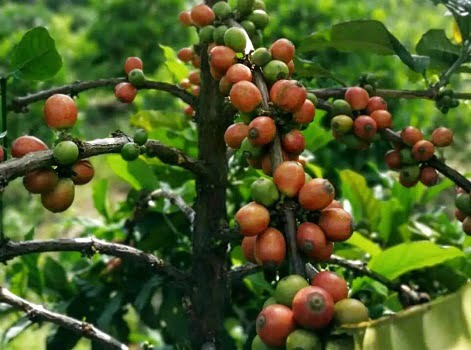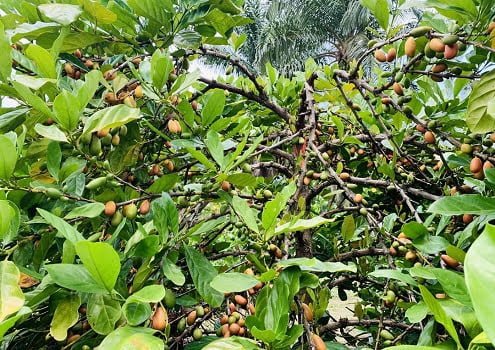Liberica coffee is one of the four main coffee varieties – Arabica, Robusta, Liberica, and Excelsa. It is mainly grown in the Philippines and Malaysia and makes up just 1-2% of global coffee production.
Key Takeaways
- Liberica trees grow exceptionally tall, up to 18 meters high.
- Liberica Plants thrive in the tropical climates of Southeast Asia.
- Liberica has a naturally sweet and fruity flavor profile.
- Liberica beans have a distinct almond shape and uneven sides.
- Liberica is more resistant to diseases than Arabica plants.
- Climate change may shift focus to resilient Liberica as Arabica farmland shrinks.

In this article, I’ll sum up everything I’ve uncovered about fascinating Liberica coffee. I’ll explore Liberica’s origins, ideal growing conditions, unique flavors, and reasons for its scarcity.
As an Amazon Associate, I earn commission from qualifying purchases.
What is Liberica Coffee?
Coffea liberica is a unique species of coffee distinct from the two most popular types: Arabica and Robusta. The beans have a distinctive oval shape with uneven sides. While other coffee plants grow like short, bushy shrubs, Liberica has a very tall structure, growing up to 18 meters like an actual tree!
Liberica is also considered the sturdiest of all coffee plants, with extra resistance to diseases, pests, and weather fluctuations. The leaves and cherries that grow on Liberica trees are noticeably bigger and elongated.
The caffeine content of Liberica is around 1.2% on a dry matter basis, on par with Arabica beans but way below the 2.6% caffeine kick of Robusta.
Due to its rarity, Liberica often fetches up to twice the price per pound compared to Arabica coffee beans in specialty auctions!
One cool thing about Liberica’s fruit structure is that the pulp makes up around 60% of the coffee cherry, while the parchment is only 40% – the ratio is 40% pulp and 60% parchment in Arabica and Robusta.
This leads to more fruity sugars being produced when the cherry is dried using a natural process and makes the resulting drink sweeter with notes of jackfruit.

History of Liberica Coffee
The Coffea Liberica species originally comes from the African country “Liberia”, as indicated by its name.
It spread to Southeast Asia in the late 1800s when European colonists brought over Liberica seeds.
This was during a time when the global coffee industry was experiencing a devastating pandemic of leaf rust disease wiping out 90% of the Arabica crops Worldwide.
But lucky for coffee lovers, Liberica beans happened to be resistant to the outbreak! So while many producers switched to Robusta, growers in the Philippines were encouraged to plant Liberica instead.
To this day, the Philippines remains one of the few major producers of Liberica coffee accounting for more than 90% of coffee produced in the country.
Where Liberica coffee is grown
These days, nearly all Liberica coffee comes from Southeast Asian countries like the Philippines, Malaysia, and Indonesia.
What sets Liberica apart is its tall structure, resilient nature, and a deeper root system that enables it to access water sources in challenging climates.
The hardy trees can survive and remain productive in harsher climates, lower altitudes, and poor soil conditions that other coffee varieties couldn’t tolerate.

What Does Liberica Coffee Taste Like?
Liberica coffee delivers a truly unique and sweet flavor profile that is quite different from other coffee types.
Liberica is commonly processed naturally, the beans ferment with more fruit mucilage layer from the sticky cherry pulp, resulting in a more sweet and fruity cup.
Liberica is significantly sweeter than Arabica with dominant notes of jackfruit and berries complemented by fragrant jasmine and rose impressions. It offers a smooth, syrupy mouthfeel and pleasant lingering sweetness after you sip.
Some people don’t like the ashy and woody notes of Liberica which is similar to Robusta beans. It can also have a weird, rubbery flavor that doesn’t go well with the fruity taste.
I tried some Liberica coffee sourced from Malaysia and found it quite nice at first, pleased by the natural sweetness and bright fruit aromas. But the strong woody, rubbery aftertaste was too overpowering for my preferences and distracted from the nice fruity hints.
Not my favorite bean, but have some interesting qualities!
Why is Liberica Coffee rare?
There are a few key reasons the Liberica coffee varietal accounts for less than 2% of global production and is considered rare compared to Arabica and Robusta coffee.
- For one, Liberica has a divisive flavor profile that’s fruitier and lighter compared to the richer and full-bodied that most coffee drinkers expect. Beyond specialty coffee circles, it hasn’t found a wide market appeal.
- Liberica also demands very specific climate conditions to thrive – high heat and humidity found in equatorial regions. This makes cultivation limited primarily to parts of Southeast Asia.
- Additionally, there is minimal scientific research done on Liberica genetics compared to extensive studies on Arabica and Robusta. So little is understood about optimizing Liberica cultivation.
- Harvesting Liberica is also far more labor intensive given the towering tree height. Pickers must use tall ladders to gather the fruit safely.
With niche demand, a limited climate range, little research support, and difficult harvesting, it’s no wonder farmers stick to easier, more profitable Robusta and Arabica coffee crops.
The Future Potential of Liberica Coffee
With its distinctive flavor, resilience, and rich history, the Liberica coffee species shows real promise emerging from its obscurity.
As climate change makes Arabica farmland unusable, producers may shift focus to sturdier Liberica trees instead. Unlike fragile Arabica crops, Liberica thrives in high heat and can withstand erratic weather.
Farmers also receive better prices for specialty Liberica versus cheap Robusta. And curious coffee lovers are attracted to its sweet cup and exotic backstory.
And if the history of coffee teaches us anything, it’s that things only really change when the alternative is no coffee at all. It may just be that liberica is a bean whose time has come.
Wired

Varieties of Liberica Coffee
Kapeng Barako
Kapeng Barako is a variety of Liberica Coffee mainly grown in the Philippines and is known for its bold flavors.
It has a strong aroma reminiscent of aniseed and a distinctively bittersweet taste. The coffee is thick and syrupy with a powerful kick thanks to its high caffeine content.
For Filipinos, Kapeng Barako is a beloved symbol of national identity and a longstanding part of local tradition. It has been grown in the Philippines for over 200 years and is considered the country’s national coffee.

Excelsa Coffee
Excelsa coffee was actually considered its own unique species until reclassification in 2006 grouped it as a sub-variety of the Liberica species.
Excelsa and Liberica coffee trees are both exceptionally tall with elongated branches, however, there are some noteworthy differences between the two beans.
- Excelsa coffee beans are distinctly smaller and rounder in shape compared to large almond-shaped Liberica beans.
- Excelsa is denser with less dissolved solubles, while Liberica is more porous with inherent sweetness.
- And when brewed, Liberica offers lighter fruit and floral notes versus Excelsa’s bolder, woodier profile.
Check out interesting articles related to other coffee beans
- What is Geisha Coffee
- What is Typica Coffee
- What is Bourbon Coffee
- What is Pacamara Coffee
- What is Caturra Coffee
Final Thoughts
And there you have it – the full lowdown on elusive Liberica coffee! From its towering trees to its sweet, fruity taste, we’ve covered everything that makes this bean so special.
Next time you spot Liberica on the menu at your local specialty cafe, I’d urge you to try it! The mellow flavor and inherent sweetness make Liberica coffee truly special.
Just be sure to verify the beans are authentically sourced from the Philippines or elsewhere in Southeast Asia before buying.
Have you had the chance to taste Liberica coffee? Or tried brewing with these rare beans yourself? I’d love to hear your thoughts on this unusual variety! Drop your Liberica experiences below!
Check out a guide on different varieties of coffee beans



